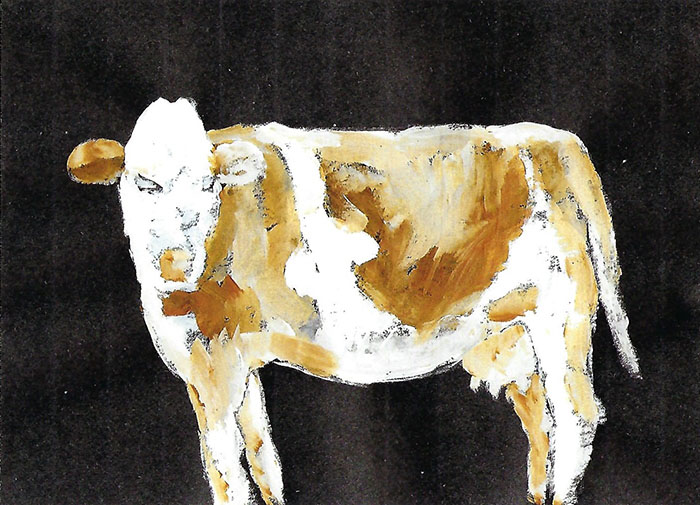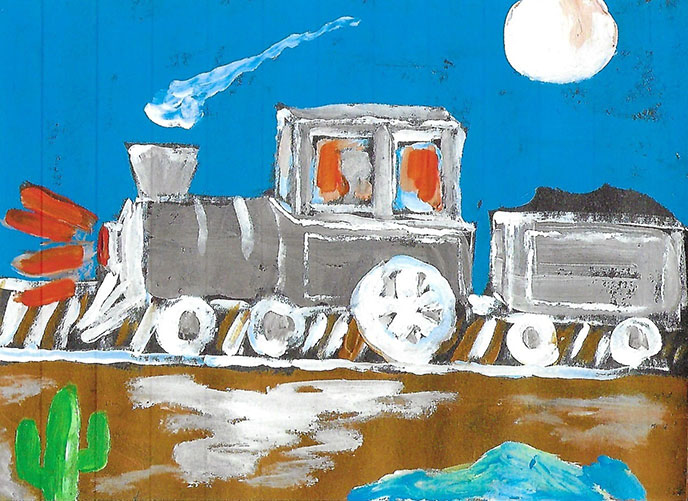Kyle Laws
After The Prose of the Trans-Siberian, Blaise Cendrars
“I forget where I am. I have to remember which direction,”
the woman in purple says as she descends circular stairs,
“traveling south or west as you pull from the station in Raton?”
The New Mexico landscape flattens into the desert off the pass,
into barbed wire that keep Black Angus and mustangs from
the tracks, the piñons that fruit every five years wide like arms
of a bear protecting her cubs, soil held to ground by short
grasses never plowed—the Dust Bowl never made it this far.We go south so we can go west, so we can stop at an early
Harvey House in Las Vegas, so we can walk the blocks
from Railroad Avenue to Charlie's Spic and Span Bakery
and Café, this not the Trans-Siberian, but crossing a country
as wide and deep, the locomotive growling at wild turkeys
climbing a butte across from a stone barn, a rusting Chevrolet
coupe beside, and bricks of adobe of a long gone ranch house
totems in the wind a red-tailed hawk glides over.
Leaving Raton Pass
We roll on rails into dusty green sagebrush and the yellow
of chamisa, into ground run by antelope and mule tail deer
and the meander of dried creek beds.No one had any hope of growing wheat here, or alfalfa,
in the flat stretches of baked grasses, a wide swatch
between the green-black of pine dotted hills.The occasional gold of cottonwoods still with leaves waves
along a running creek, highway a ribbon beside in the grey
turned soil of a volcano where tracks were laid.This is the path of the Santa Fe Trail, the Southwest Chief,
the interstate highway North/South, but before that the route
that led to the Camino Real to Mexico.The railway system was a new geometry beside dried stalks
of purple aster and black heads of sun flowers after the seeds
were picked by meadow larks and field mice made nests
in abandoned rail cars used to store hay.Eight black headed ducks paddle across what's left of the last
rain in a depression in the field. And a flock of starlings
descends into a one crossing town, goats behind houses
gnawing the ground close.When you travel by train you realize how open America is,
porous, how the water disappears as have people on the land,
more tractor trailers on the long haul,paths congregated like cattle, like Sunday under a steeple,
like stock tanks under windmills, dust swirls, devil of the plains,
kicking up along roads on All Saints Day for the folks passed on.
Quote from "The Prose of the Trans-Siberian…," Blaise Cendrars,
translated by Ron PadgettColorado’s Geometry
Where the roads are perfectly straight
and fields circular if irrigated by pivot,
but dry streambeds meander across plains
and lakes have the irregular hem of a skirt
made in a home economics class required of girls
that three years later becomes box pleated
in brown wool with tweed matched at seams.
Out of nowhere a canyon appearsyou can descend if the tread on your boots
is good enough, river that carved it called Purgatory.
Backed into the cliff is the outline of a house,
adobe gone back to earth, only the foundation left
and stubby poles that carry electricity from the top.
I cannot imagine what drives someone to these depths.
Kyle Laws is based out of the Arts Alliance Studios Community in Pueblo, CO. Her collections include This Town: Poems of Correspondence with Jared Smith (Liquid Light Press, 2017); So Bright to Blind (Five Oaks Press, 2015); Wildwood (Lummox Press, 2014); My Visions Are As Real As Your Movies, Joan of Arc Says to Rudolph Valentino (Dancing Girl Press, 2013); and George Sand’s Haiti (co-winner of Poetry West’s 2012 award). With six nominations for a Pushcart Prize, her poems and essays have appeared in magazines and anthologies in the U.S., U.K., and Canada. She is the editor and publisher of Casa de Cinco Hermanas Press. www.kylelaws.com

